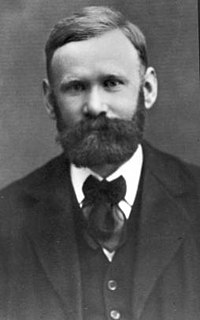This page is based on this
Wikipedia article Text is available under the
CC BY-SA 4.0 license; additional terms may apply.
Images, videos and audio are available under their respective licenses.

Agner Krarup Erlang was a Danish mathematician, statistician and engineer, who invented the fields of traffic engineering and queueing theory.
The erlang is a dimensionless unit that is used in telephony as a measure of offered load or carried load on service-providing elements such as telephone circuits or telephone switching equipment. A single cord circuit has the capacity to be used for 60 minutes in one hour. Full utilization of that capacity, 60 minutes of traffic, constitutes 1 erlang.
In distributed computing, a remote procedure call (RPC) is when a computer program causes a procedure (subroutine) to execute in a different address space, which is coded as if it were a normal (local) procedure call, without the programmer explicitly coding the details for the remote interaction. That is, the programmer writes essentially the same code whether the subroutine is local to the executing program, or remote. This is a form of client–server interaction, typically implemented via a request–response message-passing system. In the object-oriented programming paradigm, RPC calls are represented by remote method invocation (RMI). The RPC model implies a level of location transparency, namely that calling procedures is largely the same whether it is local or remote, but usually they are not identical, so local calls can be distinguished from remote calls. Remote calls are usually orders of magnitude slower and less reliable than local calls, so distinguishing them is important.
In telecommunication engineering, and in particular teletraffic engineering, the quality of voice service is specified by two measures: the grade of service (GoS) and the quality of service (QoS).

The Erlang distribution is a two-parameter family of continuous probability distributions with support
. The two parameters are:

Erlang Shen (二郎神), or Erlang is a Chinese God with a third truth-seeing eye in the middle of his forehead.

ejabberd is an XMPP application server, written mainly in the Erlang programming language.
It can run under several Unix-like operating systems such as Mac OS X, GNU/Linux, FreeBSD, NetBSD, OpenBSD and OpenSolaris. Additionally, ejabberd can run under Microsoft Windows. The name ejabberd stands for Erlang Jabber Daemon and is written in lowercase only, as is common for daemon software.
Telecommunications traffic engineering, teletraffic engineering, or traffic engineering is the application of traffic engineering theory to telecommunications. Teletraffic engineers use their knowledge of statistics including queuing theory, the nature of traffic, their practical models, their measurements and simulations to make predictions and to plan telecommunication networks such as a telephone network or the Internet. These tools and knowledge help provide reliable service at lower cost.
Tsung is a stress testing tool written in the Erlang language and distributed under the GPL license. It can currently stress test HTTP, WebDAV, LDAP, MySQL, PostgreSQL, SOAP and XMPP servers. Tsung can simulate hundreds of simultaneous users on a single system. It can also function in a clustered environment.

Yaws is a web server written in Erlang by Claes (klacke) Wikström. Yaws can be embedded into other Erlang-based applications or run as a regular standalone web server.
In telecommunications, busy-hour call attempts (BHCA) is a teletraffic engineering measurement used to evaluate and plan capacity for telephone networks. BHCA is the number of telephone calls attempted at the sliding 60-minute period during which occurs the maximum total traffic load in a given 24-hour period (BHCA), and the higher the BHCA, the higher the stress on the network processors. BHCA is not to be confused with busy hour call completion (BHCC) which measures the throughput capacity of the network. If a bottleneck in the network exists with a capacity lower than the estimated BHCA, then congestion will occur resulting in many failed calls and customer dissatisfaction.
Network traffic or data traffic is the amount of data moving across a network at a given point of time. Network data in computer networks is mostly encapsulated in network packets, which provide the load in the network. Network traffic is the main component for network traffic measurement, network traffic control and simulation.

LYME and LYCE are software stacks composed entirely of free and open-source software to build high-availability heavy duty dynamic web pages. The stacks are composed of:

Demonware is an Irish software development company and a subsidiary of Activision Blizzard. Demonware's products enable games publishers to outsource their networking requirements, allowing them to concentrate on playability. The organisation has offices in Dublin, Ireland, Vancouver, British Columbia, Canada, and Shanghai, China.
Elixir is a functional, concurrent, general-purpose programming language that runs on the Erlang virtual machine (BEAM). Elixir builds on top of Erlang and shares the same abstractions for building distributed, fault-tolerant applications. Elixir also provides a productive tooling and an extensible design. The latter is supported by compile-time metaprogramming with macros and polymorphism via protocols.
In queueing theory, a loss network is a stochastic model of a telephony network in which calls are routed around a network between nodes. The links between nodes have finite capacity and thus some calls arriving may find no route available to their destination. These calls are lost from the network, hence the name loss networks.

In probability theory, a hyper-Erlang distribution is a continuous probability distribution which takes a particular Erlang distribution Ei with probability pi. A hyper-Erlang distributed random variable X has a probability density function given by

Lisp Flavored Erlang (LFE) is a functional, concurrent, garbage collected, Turing complete, general-purpose programming language and Lisp dialect built on Core Erlang and the Erlang virtual machine (BEAM). LFE builds on Erlang to provide a Lisp syntax for writing distributed, fault-tolerant, soft real-time, non-stop applications. LFE also extends Erlang to support metaprogramming with Lisp macros and an improved developer experience with a feature-rich read–eval–print loop (REPL). LFE is actively supported on all recent releases of Erlang; the oldest version of Erlang supported is R14.







